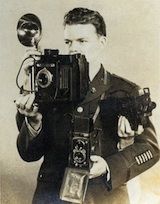- Forum
- General Discussion | Introductions | Off Topic Forum
- Photography General Discussion
- How do you use a gray card for proper exposure?
How do you use a gray card for proper exposure?
-
 Topic Author
Topic Author
- lucky1one
- Has the Hang of it
- Canon 1D Mark II
- Followers: 3
- Posts: 74
-
Points:
0
Post #104280
How about a situation in which a flash or strobe is used? My understanding is that a camera's built-in meter would not be useful, because it could not provide a reading of the flash exposure and ambient exposure at the same time... the meter is activated only after a burst of flash has occurred. That's the reason photographers use a handheld incident meter.
My question is, could you get around the problem of not having an incident meter by...
1. metering a gray card for proper exposure with the camera's built-in meter
(for example, 1/125 @ f.5.6 without flash)
2. adjust the shutter speed or aperture based on the power level setting of the flash you use.
(for example, fill light using a flash at full power.)
...since adding flash at full power = 1 f-stop increase of exposure, could I make compensation to the original meter reading (w/ gray card without flash) either by changing my shutter speed from 1/125 to 1/250 or changing my aperture from f 5.6 to f 8?
Thanks in advance for your reply!
-

- MLKstudios
- Banned
-
- D800 ;-)
- Followers: 72
- Posts: 4480
-
Points:
2
Post #104288
First of all, your shutter speed doesn't affect flash exposure like it does with ambient light. Flash control is based on the aperture (f/stop) setting alone. Your shutter speed needs to be at the camera's sync speed, or below.
Have someone hold the card in front of their face (the same distance from the light is important) and get close enough to fill the frame with it. Fire the strobe (or flash) and look at the camera's histogram. You should have a "spike" near the middle of the histogram (very slightly left is OK).
If the spike is to the right of center, stop the lens down, and if it's to the left, open it some.
You can also adjust the power setting of the light (or the light-to-subject distance).
Matthew
Matthew L Kees
MLK Studios Photography School
www.MLKstudios.com
[email protected]
"Every artist, was once an amateur"
Post #104296
MLKstudios wrote: It is possible to use an 18% card for flash exposure using some trial and error.
First of all, your shutter speed doesn't affect flash exposure like it does with ambient light. Flash control is based on the aperture (f/stop) setting alone. Your shutter speed needs to be at the camera's sync speed, or below.
Have someone hold the card in front of their face (the same distance from the light is important) and get close enough to fill the frame with it. Fire the strobe (or flash) and look at the camera's histogram. You should have a "spike" near the middle of the histogram (very slightly left is OK).
If the spike is to the right of center, stop the lens down, and if it's to the left, open it some.
You can also adjust the power setting of the light (or the light-to-subject distance).
Matthew
Good to know. Thank you, Mathew.
What week is this covered in?
“Amateurs worry about equipment, professionals worry about money, masters worry about light, I just make pictures… ” ~ Vernon Trent
-
 Topic Author
Topic Author
- lucky1one
- Has the Hang of it
- Canon 1D Mark II
- Followers: 3
- Posts: 74
-
Points:
0
Post #104300
I am thinking about purchasing the Photovision 14" pocket one-shot digital calibration target. At the same time, I hear a lot about the X-Rite color checker. What do you think about them?
-

- photobod
- Paparazzi
-
- Nikon D800 + D300
- Followers: 563
- Posts: 8907
-
Points:
150
Post #104352
This ensures that skin tones remain the same even when zooming in from body shots to head shots.
www.dcimages.org.uk
"A good photograph is one that communicate a fact, touches the heart, leaves the viewer a changed person for having seen it. It is, in a word, effective." - Irving Penn
-

- Henry Peach
- Apprentice
-
- I currently use a 5DII or Sony Nex-3 most of the time.
- Followers: 50
- Posts: 2925
-
Points:
16
Post #104420
Guide number divided by distance to subject = f/stop for normal exposure
-

- MLKstudios
- Banned
-
- D800 ;-)
- Followers: 72
- Posts: 4480
-
Points:
2
Post #104448
HP, I cover guide numbers too, but today many people add an umbrella or softbox (Wescott makes a few for flashes now) or some other kind of diffuser. They throw the guide numbers out the window. But I agree, the GN of your flash is very important to know.
BTW not all companies are using ISO 100 anymore. It rates better at ISO 200. Marketing.
Matthew L Kees
MLK Studios Photography School
www.MLKstudios.com
[email protected]
"Every artist, was once an amateur"
-

- Superman
- Photography Hooked
-
- Nikon D810 and Z6
- Followers: 118
- Posts: 688
-
Points:
2393
-
 Topic Author
Topic Author
- lucky1one
- Has the Hang of it
- Canon 1D Mark II
- Followers: 3
- Posts: 74
-
Points:
0
-

- MLKstudios
- Banned
-
- D800 ;-)
- Followers: 72
- Posts: 4480
-
Points:
2
Post #105680
Later, they realized the color was neutral enough to be used for white balance too, and were able to ride the digital wave.
They're expensive, and many like them. However, you can get as good or better WB and exposure using cheaper tools. A KODAK (or Delta) brand gray card for exposure and a Robin Myers Imaging or similar for white balance will cost about $25 USD.
I also make my own dual purpose cards based on the RMI card. I paint one side of it 18% gray so it can be used for both -- exposure and white balance.
Matthew
Matthew L Kees
MLK Studios Photography School
www.MLKstudios.com
[email protected]
"Every artist, was once an amateur"
-
 Topic Author
Topic Author
- lucky1one
- Has the Hang of it
- Canon 1D Mark II
- Followers: 3
- Posts: 74
-
Points:
0
Post #105977
When using a flash/strobe with an Expodisc (or a gray card for that matter) to set proper exposure, I have to take the extra steps to check the histogram after taking a shot, make adjustment to my exposure setting, take another shot, check the histogram again and so on until I nail the correct exposure. It's essentially chimping with a highly accurate histogram instead of a less reliable LCD screen.
This is where I think a handheld flash meter has its advantage when shooting with a flash, because once you sync the ISO and shutter speed between the camera and the flash meter, it will tell you the EXACT aperture to use to get a correct exposure. Take a flash metering, set the aperture on the camera, take a shot, and you're done.
I watched the video lesson from Expodisc's website in which the presenter was teaching the viewer how to use it in a studio setting to get proper exposure. However, he used a hot strobe for continuous lighting. What I wanted to see instead is how it could be used with flash units. I think more people use flash units than continuous lighting.
I've never used a flash meter or an Expodisc to set proper exposure, so please correct me if anything I said is not right. Thanks.
-

- MLKstudios
- Banned
-
- D800 ;-)
- Followers: 72
- Posts: 4480
-
Points:
2
Post #106807
I think you got the ideas right, but your "lingo" is off a bit. ANY light called a strobe "blinks", by definition. You're correct that sometimes continuous lighting is called HOT lighting.
A 500 watt photoflood bulb, or 2K Fresnel movie lights, get so hot they can melt the things they light.
The newer fluorescent lights are the exception. They're continuous without getting hot.
Matthew
Matthew L Kees
MLK Studios Photography School
www.MLKstudios.com
[email protected]
"Every artist, was once an amateur"
-
 Topic Author
Topic Author
- lucky1one
- Has the Hang of it
- Canon 1D Mark II
- Followers: 3
- Posts: 74
-
Points:
0
Post #106884
I've never owned a monolight before, but I have a couple of speedlights. As a beginner who is learning portrait photography, there were times I wished that I had modeling lights to help me take the guess work out of where my lights will fall. I think my next purchase will be a good flash meter and a monolight, perhaps a White Lightning or Einstein by Paul C. Buff.
- Forum
- General Discussion | Introductions | Off Topic Forum
- Photography General Discussion
- How do you use a gray card for proper exposure?
Latest Reviews
The Canon EOS R100 is an entry-level mirrorless camera introduced in 2023. But just because it’s an entry-level camera doesn’t mean it’s a bare-bones camera. Find out why in this review!
Nikon’s retro-looking Nikon Zfc is anything but retro. Under its classic body is a host of features and amenities that make it a worthwhile compact mirrorless camera for 2024.
The Canon EOS R50 is one of the newest R-system cameras from Canon. Is it worth your money? Find out all the details you need to know in this comprehensive review.
The Sony FE 70-200mm f/2.8 GM OSS II is Sony’s flagship mirrorless zoom lens. As such, it’s loaded with features and has a top-shelf build quality that makes it a top pick!
Latest Articles
The Insta360 has one of the best lineups of action cams and 360-degree cameras. With these Insta360 accessories, you can elevate your photography and videography game!
Creating impactful photos of landscapes depends on many factors, not the least of which is your talent behind the lens. This guide explores other elements required for the best product.
The Canon EOS R100 is an entry-level mirrorless camera introduced in 2023. But just because it’s an entry-level camera doesn’t mean it’s a bare-bones camera. Find out why in this review!
Are you ready to upgrade your camera? Before buying new, you might consider the value of purchasing used gear to save money.
The Olympus OM-D E-M10 Mark IV is a micro four thirds camera released in 2020. It’s an entry-level system along with the OM-D E-M5 Mark III. Use this guide to determine which one is best for you!
Blue hour photography might not be as well known as golden hour photography, but it is every bit as good a time to create epic images of landscapes. Learn how in this quick tutorial!
Nikon’s retro-looking Nikon Zfc is anything but retro. Under its classic body is a host of features and amenities that make it a worthwhile compact mirrorless camera for 2024.
Moving from taking snapshots of your dog to creating beautiful images doesn’t have to be that difficult! Use the tips outlined in this dog photography guide, and you’ll get better results in no time.
















